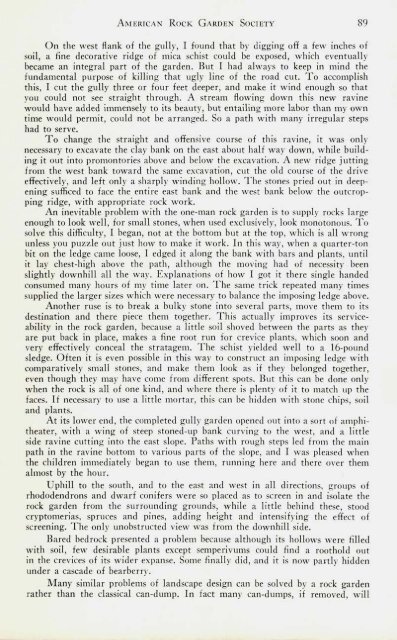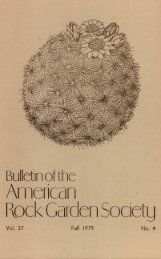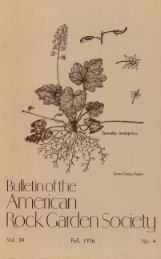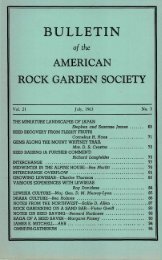Bulletin - July 1956 - North American Rock Garden Society
Bulletin - July 1956 - North American Rock Garden Society
Bulletin - July 1956 - North American Rock Garden Society
Create successful ePaper yourself
Turn your PDF publications into a flip-book with our unique Google optimized e-Paper software.
AMERICAN ROCK GARDEN SOCIETY 89On the west flank of the gully, I found that by digging off a few inches ofsoil, a fine decorative ridge of mica schist could be exposed, which eventuallybecame an integral part of the garden. But I had always to keep in mind thefundamental purpose of killing that ugly line of the road cut. To accomplishthis, I cut the gully three or four feet deeper, and make it wind enough so thatyou could not see straight through. A stream flowing down this new ravinewould have added immensely to its beauty, but entailing more labor than my owntime would permit, could not be arranged. So a path with many irregular stepshad to serve.To change the straight and offensive course of this ravine, it was onlynecessary to excavate the clay bank on the east about half way down, while buildingit out into promontories above and below the excavation. A new ridge juttingfrom the west bank toward the same excavation, cut the old course of the driveeffectively, and left only a sharply winding hollow. The stones pried out in deepeningsufficed to face the entire east bank and the west bank below the outcroppingridge, with appropriate rock work.An inevitable problem with the one-man rock garden is to supply rocks largeenough to look well, for small stones, when used exclusively, look monotonous. Tosolve this difficulty, I began, not at the bottom but at the top, which is all wrongunless you puzzle out just how to make it work. In this way, when a quarter-tonbit on the ledge came loose, I edged it along the bank with bars and plants, untilit lay chest-high above the path, although the moving had of necessity beenslightly downhill all the way. Explanations of how I got it there single handedconsumed many hours of my time later on. The same trick repeated many timessupplied the larger sizes which were necessary to balance the imposing ledge above.Another ruse is to break a bulky stone into several parts, move them to itsdestination and there piece them together. This actually improves its serviceabilityin the rock garden, because a little soil shoved between the parts as theyare put back in place, makes a fine root run for crevice plants, which soon andvery effectively conceal the stratagem. The schist yielded well to a 16-poundsledge. Often it is even possible in this way to construct an imposing ledge withcomparatively small stones, and make them look as if they belonged together,even though they may have come from different spots. But this can be done onlywhen the rock is all of one kind, and where there is plenty of it to match up thefaces. If necessary to use a little mortar, this can be hidden with stone chips, soiland plants.At its lower end, the completed gully garden opened out into a sort of amphitheater,with a wing of steep stoned-up bank curving to the west, and a littleside ravine cutting into the east slope. Paths with rough steps led from the mainpath in the ravine bottom to various parts of the slope, and I was pleased whenthe children immediately began to use them, running here and there over themalmost by the hour.Uphill to the south, and to the east and west in all directions, groups ofrhododendrons and dwarf conifers were so placed as to screen in and isolate therock garden from the surrounding grounds, while a little behind these, stoodcryptomerias, spruces and pines, adding height and intensifying the effect ofscreening. The only unobstructed view was from the downhill side.Bared bedrock presented a problem because although its hollows were filledwith soil, few desirable plants except semperivums could find a roothold outin the crevices of its wider expanse. Some finally did, and it is now partly hiddenunder a cascade of bearberry.Many similar problems of landscape design can be solved by a rock gardenrather than the classical can-dump. In fact many can-dumps, if removed, will









